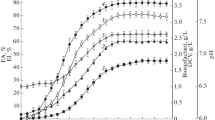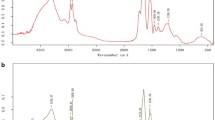Abstract
Background
Biosurfactants are amphipathic biological compounds with surface active potential and are produced by many microorganisms. Biosurfactant production by Lysinibacillus fusiformis MK559526 isolated from automobile-mechanic-shop soil was investigated with a view to assessing its potential for production and potential for optimization.
Materials and methods
Effects of carbon and nitrogen sources, pH, temperature and incubation periods on biosurfactant production were evaluated with a view to optimizing the processes. Fourier Transform Infra-Red absorption peaks and Gas chromatography mass spectrometry were used to determine the functional groups of the chemical make-up and the chemical profile of the biosurfactant respectively.
Results
Lysinibacillus fusiformis surfactant had emulsification index of 65.15 ± 0.35 %, oil displacement of 2.7 ± 0.26 mm, zone of haemolysis of 7.3 ± 0.16 mm and a positive drop collapse test. Optimized culture conditions for biosurfactant production: temperature, 35 ºC; pH, 7.0; starch solution, 40 g/L and urea, 1.5 g/L showed a reduction in surface tension to 28.46 ± 1.11 mN/m and increased emulsification index to 93.80 ± 0.41 %. Maximum biosurfactant production of 2.92 ± 0.04 g/L was obtained after 72 h. The biosurfactant contained peptides and fatty acids. The predominant fatty acid was 9-Octadecenoic acid (80.80%).
Conclusions
The above results showing high emulsification potential and remarkable reduction in the surface tension are good biosurfactant attributes. Consequently, Lysinibacillus fusiformis MK559526 is a good candidate for biosurfactant production.





Similar content being viewed by others
Change history
15 March 2021
A Correction to this paper has been published: https://doi.org/10.1007/s42770-021-00435-0
References
Parthipan P, Preetham E, Machuca LL, Rahman PKSM, Murugan K, Rajasekar A (2017) Biosurfactant and degradative enzymes mediated crude oil degradation by bacterium Bacillus subtilis A1. Front Microbiol 8:1–14
Mulligan CN, Sharma SK, Mudhoo A (2014) Biosurfactants. research trends and applications. CRC Press Taylor and Francis Group, Boca Raton, London, New York
Abdul HN, Mohamed SM, Lai Y (2018) Culture medium development for microbial-derived surfactants production—an overview. Molecules 23(5):1049. https://doi.org/10.3390/molecules23051049
Perfumo A, Smyth TJP, Marchant R, Banat IM (2010) Production and roles of biosurfactants and bioemulsifiers in accessing hydrophobic substrates. In: Timmis KN (ed) Handbook of hydrocarbon and lipid microbiology. Springer, Berlin, pp 1501–1512
Elazzazya AM, Abdelmoneima TS, Almaghrabi OA (2015) Isolation and characterization of biosurfactant production under extreme environmental conditions by alkali-halo-thermophilic bacteria from Saudi Arabia. Saudi J Biol Sci 22(4):466–475
Shoeb E, Faiza A, Uzma B, Jameela A, Samina I (2013) Classification and industrial applications of biosurfactants. Acad Res Int 4(3):243–252
Nakano MM, Corbell N, Besson J, Zuber P (1992) Isolation and characterization of Sfp: a gene that functions in the production of the lipopeptide biosurfactant, surfactin, in Bacillus subtilis. Mol Gen Genet 232:313–321
Makkar RS, Cameotra SS, Banat IM (2011) Advances in utilization of renewable substrates for biosurfactant production. J Appl Microbiol Biotechnol 1:1–19. https://doi.org/10.1186/2191-0855-1-5
Sidkey NM, Mohamed HF, Elkhouly IH (2016) Evaluation of different screening methods for biosurfactant producers isolated from contaminated Egyptian samples grown on industrial olive oil processing waste. Br Microbiol Res J 17(4):1–19. https://doi.org/10.8734/BMRI/2016/28437
Wang XB, Nie Y, Tang YQ, Wu G, Wu XL (2013) N-alkane chain length alters Dietzia Sp. strain DQ12-45-1b biosurfactant production and cell surface activity. Appl Environ Microbiol 79:400–402. https://doi.org/10.1128/AEM.02497-12
John WC (2019) Detection of surfactin gene in biosurfactant producing Bacillus species from different contaminated soil in Makurdi metropolis. PhD Thesis, Federal University of Agriculture, Makurdi, Nigeria
Balogun SA, Fagade OE (2010) Emulsifying bacteria in produce water from Niger Delta, Nigeria. Afr J Microbiol Res 4(9):730–734
Seema D, Nakuleshwar DJ (2012) Isolation of biosurfactant-producing marine bacteria. Afr J Environ Sci Technol 6(6):263–266
Hasham MM, Mohamed AF, Mohamed NH (2012) Production of biosurfactant from certain Candida strains under special conditions. Researcher 4(7):39–55
El-Shahawy MR (2014) Biosynthesis of biosurfactant by Egyptian local bacterial isolates using different agricultural wastes. J Nucl Technol Appl Sci 2(4):409–417
Anitha J, Jeyanthi V, Ganesh P (2015) Production and characterization of biosurfactant by Bacillus and its applicability in enhanced oil recovery. Int J Adv Res Biol Sci 2(5):7–16
Putri M, Hertad R (2015) Effect of glycerol as carbon source for biosurfactant production by halophilic bacteria Pseudomonas stutzeri BK-AB12. Procedia Chem 16:321–327
Barakat KM, Sahar WM, Hassan O, Darwesh M (2017) Biosurfactant production by haloalkaliphilic Bacillus strains isolated from Red Sea, Egypt. Egypt J Aquat Res 3(5):1–7
El-Sersy N (2012) A Plackett-Burman design to optimize biosurfactant production by marine Bacillus subtilis N10. Rom Biotechnol Lett 17(2):7049–7064
Jagtap S, Yavankar S, Pardesi K, Chopade P (2010) Production of bioemulsifier by Acinetobacter species isolated form healthy human skin. Indian J Exp Biol 48:70–76
Husam SA, Ahmed IM (2013) Effect of different environmental and nutritional factors on biosurfactant production from Azotobacter chrococcum. Int J Adv Pharm Biol Chem 2(3):477–481
Sonali S, Sriparna D, Dipa B (2011) Optimization of culture conditions for biosurfactant production from Pseudomonas aeruginosa OCD. J Adv Sci Res 2(3):32–36
Jain RM, Mody K, Mishra A, Jha B (2013) Colloids and surfaces. Bio-interfaces 108:199–204
Youssef NH, Duncan KE, Mcinerney MJ (2005) Importance of 3-hydroxy fatty acid composition of lipopeptides for biosurfactant activity. Appl Environ Microbiol 71:7690–7695
Zhang J, Xue Q, Gao H, Lai H, Wang P (2016) Production of lipopeptide biosurfactants by Bacillus atrophaeus 5-2a and their potential use in microbial enhanced oil recovery. Microb Cell Factories 15:168. https://doi.org/10.1186/s12934-016-0574-8
Saharan BS, Sahu RK, Sharma DA (2012) Review on biosurfactants: fermentation, current developments and perspectives. Genet Eng Biotechnol J 1:1–14
Desai AJ, Patel RM, Desai JD (1994) Advances in production of biosurfactant and their commercial applications. J Sci Ind Res 53:619–629
Joshi I, Sanket J, Yahya M, Al-Wahaibi Saif N, Al-Bahry A, Abdulkadir E, Elshafie C, Ali S, Al-Bemani B, Asma Al-Bahri A, Musallam S, Al-Mandhari R (2016) Production, characterization and application of Bacillus licheniformis W16 biosurfactant in enhancing oil recovery. Front Microbiol 7:1–14
Ren K (2018) Synthesis of some biobased surfactants, and their functionalities as emulsifiers and antimicrobial agents. Graduate Theses and Dissertations. Iowa State University, Capstones. https://lib.dr.iastste.edu/etd
Viramontes-Ramos S, Ballinas-Casarrubias Portillo-Ruiz MCML, Muñoz JVT, Rivera-Chavira BE, Nevárez-Moorillón GV (2010) Selection of biosurfactant / bioemulsifier-producing bacteria from hydrocarbon contaminated soil. Braz J Microbiol 41:668–675
Maia PCVS, Santos VP, Fereira AS, Luna MAC, Silva TAL, Andrade RFS, Campos-Takaki GM (2018) An efficient bioemulsifier-producing Bacillus subtilis UCP 0146 isolated from mangrove sediments. Colloids Interfaces 2:58. https://doi.org/10.3390/colloids2040058
Phulpoto IA, Yu Z, Hu B, Wang Y, Ndayisenga F, Li J, Liang H, Qazi MA (2020) Production and characterization of surfactin-like biosurfactant produced by novel strain Bacillus nealsonii S2MT and it’s potential for oil contaminated soil remediation. Microb Cell Factories 19:145. https://doi.org/10.1186/s12934-020-01402-4
Araújo SCS, Silva-portela RCB, de Lima DC, da fonsêca MMB, Araújo WJ, da Silva UB, Napp AP, Pereira E, Vainstein MH, Agnez-Lima LF (2020) MBSP1: a biosurfactant protein derived from a metagenomic library with activity in oil degradation. Sci Rep 10:1340
Barakat KM, Hassan SWM, Darwesh OM (2017) Biosurfactant production by haloalkaliphilic Bacillus strains isolated from Red Sea Egypt. Egypt J Aquat Res 43(2):205–211
Gudiña EJ, Pereira JFB, Costa R, Evtuguin DV, Coutinho JAP, Teixeira JA, Rodrigues LR (2015) Novel bioemulsifier produced by a Paenibacillus strain isolated from crude oil. Microb Cell Factories 14:14. https://doi.org/10.1186/s12934-015-0197-5
Sohail R, Jamil N (2020) Isolation of biosurfactant producing bacteria from Potwar oil fields: effect of non-fossil fuel based carbon sources. Green Process Synth 9:77–86
Purwasena IA, Astuti D, Syukron M, Amaniyah M, Sugai Y (2019) Stability test of biosurfactant produced by Bacillus licheniformis DS1 using experimental design and its application for MEOR. J Pet Sci Eng 183:106383
Astuti DI, Purwasena IA, Putri RE, Amaniyah M, Sugai Y (2019) Screening and characterization of biosurfactant produced by Pseudoxanthomonas sp. G3 and its applicability for enhanced oil recovery. J Pet Explor Prod Technol 9:2279–2289
Faria AF, Teodoro-Martinez DS, Barbosa GNO, Vaz BG, Silva IS, Garcia JS (2011) Production and structural characterization of Surfactin (C14/Leu7) produced by Bacillus subtilis isolate LSFM-05 grown on raw glycerol from the biodiesel industry. Process Biochem 46:1951–1957
Seghal KG, Anto TT, Selvin J, Sabarathnam B, Lipton AP (2010) Optimization and characterization of a new lipopeptide biosurfactant produced by marine Brevibacterium aureum MSA13 in solid state culture. Bioresour Technol 101:2389–2396
Pradhan AK, Pradhan N, Sukla LB, Panda PK, Mishra BK (2014) Inhibition of pathogenic bacterial biofilm by biosurfactant produced by Lysinibacillus fusiformis S9[J]. Bioprocess Biosyst Eng 37(2):139–149
Kim BN, Joo YC, Kim YS, Kim KR, Oh DK (2012) Production of 10-hydroxystearic acid from oleic acid and olive oil hydrolyzate by an oleate hydratase from Lysinibacillus fusiformis. Appl Microbiol Biotechnol 95(4):929–937
Li SW, Huang YX, Liu MY (2020) Transcriptome profiling reveals the molecular processes for survival of Lysinibacillus fusiformis strain 15-4 in petroleum environments. Ecotoxicol Environ Saf 192:110250
Author information
Authors and Affiliations
Contributions
The author has gained full consent from the responsible authorities at the institution where the research has been carried out.
Corresponding author
Ethics declarations
Conflict of interest
The authors declare that they have no conflict of interest.
Ethical approval
Not applicable.
Consent to participate
Not applicable.
Consent to publish
Not applicable.
Additional information
Responsible Editor: Inês Conceição Roberto
Publisher’s note
Springer Nature remains neutral with regard to jurisdictional claims in published maps and institutional affiliations.
The original online version of this article was revised: in the original publication of the article, the first author’s name was incorrect. The correct name is Walter Chinaka John , not Walter Chika John.
Rights and permissions
About this article
Cite this article
John, W.C., Ogbonna, I.O., Gberikon, G.M. et al. Evaluation of biosurfactant production potential of Lysinibacillus fusiformis MK559526 isolated from automobile-mechanic-workshop soil. Braz J Microbiol 52, 663–674 (2021). https://doi.org/10.1007/s42770-021-00432-3
Received:
Accepted:
Published:
Issue Date:
DOI: https://doi.org/10.1007/s42770-021-00432-3




